The late baroque or rococo, with its distinctive sweetness and elegance, arises in architecture and visual art. The clothing has light pastel shades, and ruffles and accessories come back. Louis is not interested in state affairs or the poor people. His mistress, Madame de Pompadour, influences fashion: it is feminine, playful and airy. The Age of Enlightenment began, characterized by an informal clothing style with accessories and motifs from nature. There is civilized conversations and people read a lot.
The Rococo fashion was based on extravagance, elegance, refinement and decoration. Women’s fashion of the seventeenth-century was contrasted by the fashion of the eighteenth-century, which was ornate and sophisticated, the true style of Rococo. This time was known as the ‘Enlightenment’, which valued reason over authority. The influence for art, culture, and fashion shifted its’ centre from Versailles to Paris. The exuberant, playful, elegant style of decoration and design that we now know to be ‘Rococo’ was then known as ‘le style rocaille’, ‘le style moderne’, ‘le gout’.
The Robe Volante came into fashion for women: a pretty shapeless dress with petticoats and a dress with a wide double (Watteau) fold on the shoulders. The décolleté is usually square. The hairs are tied back and lightly decorated. This has a tight, V-shaped body with bows and décolleté, and sleeves with cuffs. The skirt or panier is becoming wider and more pompous and around 1765 sometimes has a diameter of 5 meters, so women have to go sideways through a door. Women powder their own hair with chalk or flour. They wear it briefly, with curls around the head, or put up and covered with a flat hat with hanging ribbons or a bouquet. A lot of powder and rouge is used.
During the rococo the men's clothing will be less substantial. The tailored jacket has a flared back panel; the ruffles of the shirt come out. The stockings get a lighter color and the man wears black low shoes with a silver buckle. New is the English redingote, a buttoned long dressing gown. The wigs are less heavily powdered and white.
The industrial revolution, which had begun in the United Kingdom, completely revolutionized the means of making clothing. Until then, the fabrics and the clothes were produced manually, and by means craftsmanship. The creation of spinning jenny in 1764 by the British James Hargreaves and later spinning mule.
Fashion changed more and more frequently, but only rich people could afford the luxury of getting the latest fashion trend. However, many people still preferred to wear clothes made by a craftsman when they could pay for it. Other people, especially those in isolated places, continued to make fabrics and clothing at home.
Changes in fashion in the period
1750s
Women: Court dress included elaborate and intricate styles influenced by Rococo; hoop skirts; panniers; corsets; petticoats; stays; conical torso shape with large hips; "standardized courtly bodies and faces" with little individuality
French: Elaborate court dress, colorful,decorative, portraiture inside
English: Simple and practical, inexpensive durable fabrics, outdoor lifestyle, portraiture outside
Men: Coat; waistcoat: breeches; large cuffs; more attention on individual pieces of the suit; wigs for formal occasions; long and powdered hair
1760s
Women: New strapless stays cut high at the armpit; grand habit de cour or "stiff-bodied" gown; riding habit
Men: Frock coat; knee length breeches fitted snugly; full shirt sleeves; original Macaroni
1770s
Women: robe à la française or sack-back gown; robe à l'anglaise or close-bodied gown; the Brunswick; tall hair and headdresses
Men: Waistcoats began to shorten; Macaroni imitators
Women's fashion
Overview
Women's clothing styles retained the emphasis on a narrow, inverted conical torso, achieved with boned stays, above full skirts. Hoop skirts continued to be worn, reaching their largest size in the 1750s, and were sometimes replaced by side-hoops, also called 'false hips', or panniers. Court dress had little or no physical comfort with restriction of movement. Full size hoops skirts prevented sitting and reminded those wearing them to stand in the presence of the King. Stays forced a proper standing posture. Garments like these could not be washed often because of the fabrics from which they were made. The Enlightenment produced a backlash against sumptuary laws which asserted a stagnant social hierarchy. During the Enlightenment, court dress stayed almost the same while outside of court dress, fashion became less extravagant and shifted more towards comfort rather than courtly display.
Gowns
The usual fashion of the years 1750–1775 was a low-necked gown (usually called in French a robe), worn over a petticoat. Most gowns had skirts that opened in front to show the petticoat worn beneath. If the bodice of the gown was open in front, the opening was filled in with a decorative stomacher, pinned to the gown over the laces or to the stays beneath.
Close-fitting sleeves just past the elbow were trimmed with frills or ruffles, and separate under-ruffles referred to as engageantes in modern terms, of lace or fine linen were tacked, to the inside of the gown’s sleeves, or perhaps to the shift or chemise sleeves. The neckline was trimmed with a fabric or lace ruffle, or a neckerchief called a fichu could be tucked into the low neckline. Women would also sometimes wear a neckerchief or a more formal lace modesty piece, particularly on low-cut dresses.
The robe à la française or sack-back gown featured back pleats hanging loosely from the neckline. A fitted bodice held the front of the gown closely to the figure.
The robe à l'anglaise or close-bodied gown featured back pleats sewn in place to fit closely to the body, and then released into the skirt which would be draped in various ways.
The Brunswick dress was a two-piece costume of German origin consisting of a hip-length jacket with "split sleeves" (flounced elbow-length sleeves and long, tight lower sleeves) and a hood, worn with a matching petticoat. It was popular for traveling.
Court dress, the grand habit de cour or "stiff-bodied" gown, retained the styles of the 1670s. It featured a low, oval neckline that bared the shoulders, and the heavily boned bodice laced closed in back, unlike the front-opening robe. The elbow-length sleeves were covered with tiers of lace flounces, echoing the full-sleeved chemise worn with the original style.
Front-wrapping thigh-length shortgowns or bedgowns of lightweight printed cotton fabric were fashionable at-home morning wear, worn with petticoats. Over time, bedgowns became the staple upper garment of British and American female working-class street wear.
As in previous periods, the traditional riding habit consisted of a tailored jacket like a man's coat, worn with a high-necked shirt, a waistcoat, a petticoat, and a hat. Alternatively, the jacket and a false waistcoat-front might be a made as a single garment, and later in the period a simpler riding jacket and petticoat (without waistcoat) could be worn.
Underwear
The shift, chemise (in France), or smock, had a low neckline and elbow-length sleeves which were full early in the period and became increasingly narrow as the century progressed. Drawers were not worn in this period.
The long-waisted, heavily boned stays of the early 1740s with their narrow back, wide front, and shoulder straps gave way by the 1760s to strapless stays which still were cut high at the armpit, to encourage a woman to stand with her shoulders slightly back, a fashionable posture. The fashionable shape was a rather conical torso, with large hips. The waist was not particularly small. Stays were laced snugly, but comfortably. They offered back support for heavy lifting, and poor and middle class women were able to work comfortably in them.
Free-hanging pockets were tied around the waist and were accessed through pocket slits in the side-seams of the gown or petticoat.
Woollen or quilted waistcoats were worn over the stays and under the gown for warmth, as were petticoats quilted with wool batting, especially in the cold climates of Northern Europe and America. In the 1770s stays began to be produced so they would end higher on a woman's body. Phillip Vicker complained: ''For the late importation of Stays which are said to be now most fashionable in London, are produced upwards so high that we can have scarce any view at all of the Ladies Snowy Bosoms...''
Shoes
Shoes had high, curved heels (the origin of modern "louis heels") and were made of fabric or leather, with separate shoe buckles. These were either shiny metal, usually in silver (sometimes with the metal cut into false stones in the Paris style), or with paste stones, although there were other types.
Hairstyles and headgear
By the 1770s extreme hairstyles and wigs had come into fashion. Women wore their hair high upon their heads, in large plumes. To create tall extreme hair, rolls of horse hair, tow, or wool was used to raise up the front of the hair. The front of the hair was then frizzed out, or arranged in roll curls and set horizontally on the head. Women turned their hair up in the back often in a knot. In addition, pomatum and false hair was used to give more height to the hair. Pomatum was paste that women used to stiffen their hair. Pomatum was also used to hold powder, which women put in their hair. The Pomatum was made of many ingredients including hog's grease, tallow, or a mix of beef marrow and oil.
Style gallery
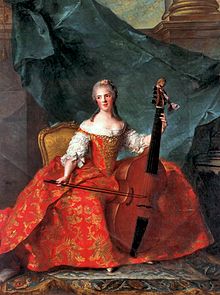
1-1750–52
| 
2-1767
| 
3 – 1755
| 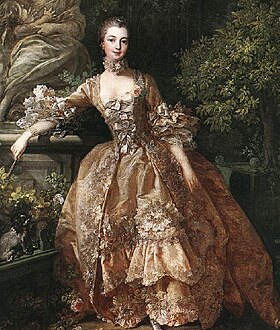
4 – 1759
| 
5 – 1774
|
|---|
2.Lady Mary Fox wears a grey silk hooded Brunswick gown with striped ribbon ornaments, 1767.
3.1755 portrait of Madame de Pompadour wearing a floral gown with matching petticoat. Her sleeves end in flounces worn over lace engageantes. Her stomacher is decorated with a vertical row of ribbon bows.
4.1759 portrait of Madame de Pompadour shows her petticoat trimmed with flounces to match her gown. She wears a small lace ruff around her neck.
5.Side view of a frock of 1774 shows pleated robings and striped ribbon rosettes.
Men's fashion
Overview
Throughout the period, men continued to wear the coat, waistcoat and breeches of the previous period. However, changes were seen in both the fabric used as well as the cut of these garments. More attention was paid to individual pieces of the suit, and each element underwent stylistic changes. Under new enthusiasms for outdoor sports and country pursuits, the elaborately embroidered silks and velvets characteristic of "full dress" or formal attire earlier in the century gradually gave way to carefully tailored woollen "undress" garments for all occasions except the most formal. This more casual style reflected the dominating image of "nonchalance." The goal was to look as fashionable as possible with seemingly little effort. This was to be the new, predominant mindset of fashion.
Coats
The skirts of the coat narrowed from the gored styles of the previous period. Waistcoats extended to mid-thigh to the 1770s and then began to shorten. Waistcoats could be made with or without sleeves.
As in the previous period, a loose, T-shaped silk, cotton or linen gown called a banyan was worn at home as a sort of dressing gown over the shirt, waistcoat, and breeches. Men of an intellectual or philosophical bent were painted wearing banyans, with their own hair or a soft cap rather than a wig.
A coat with a wide collar called a frock coat, derived from a traditional working-class coat, was worn for hunting and other country pursuits in both Britain and America.
Shirt and stock
Shirt sleeves were full, gathered at the wrist and dropped shoulder. Full-dress shirts had ruffles of fine fabric or lace, while undress shirts ended in plain wrist bands.
Breeches, shoes, and stockings
Knee-length breeches fitted snugly and had a fall-front opening.
Low-heeled leather shoes fastened with buckles were worn with silk or woollen stockings. Boots were worn for riding. The buckles were either polished metal, usually in silver (sometimes with the metal cut into false stones in the Paris style), or with paste stones, although there were other types. These buckles were often quite large and one of the world's largest collections can be seen at Kenwood House.
Hairstyles and headgear
Wigs were worn for formal occasions, or the hair was worn long and powdered, brushed back from the forehead and clubbed (tied back at the nape of the neck) with a black ribbon. Wigs were generally now short, but long wigs continued to be popular with the older generation. Wigs were made with a lot of white powder.
Wide-brimmed hats turned up on three sides called "cocked hats" (called tricorns in later eras) were worn in mid-century.
The macaroni
The trend of the macaroni grew out of the tradition of those who partook of the Grand Tour. Elite men in the 18th century would travel abroad across Europe, namely Italy, to broaden their cultural depth. These men adopted foreign fashions and tastes and brought them back to England where they interpreted them further. The original macaroni of the 1760s was characterized by elaborate dress consisting of short and tight trousers, large wigs, delicate shoes and small hats. As the general population of English males became exposed to the luxurious appeal of the macaroni trend, they began to adopt and replicate the trends they saw. By the 1770s, any man could appear as if they themselves had been on the Grand Tour based solely on their outward appearance.
The macaroni and the subsequent imitators were criticized for being gender ambiguous and effeminate. Frequently, the macaroni fashion trend was the subject of satirical caricatures and pamphlets. Their large costume like wigs and short coats, which deeply contrasted the masculine British dress of the time, were ridiculed for their frivolity and were said to be threatening the stability of gender difference, thereby undermining the nation's reputation. The question of farce and inauthenticity comes into play as well because by dressing as a macaroni, one claimed the status and the means of an elite who went on the Grand Tour.
Though many mocked the macaroni for their outwardly eccentric characteristics, some celebrated them for their commitment to the demonstration of personal identity. The idea of a unique character was becoming an important concept that spanned many types of media including books and prints as Britain wanted to distinguish itself from France.
Style gallery
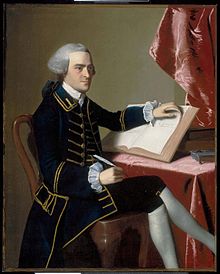
1-1764
| 
2-1760
| 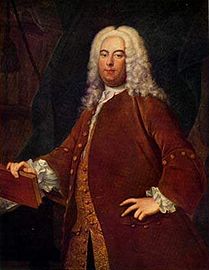
3 – 1756
| 
4 - 1764
| 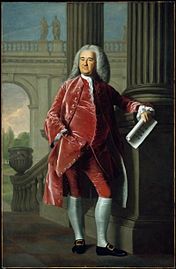
5 - 1764
|
|---|
2.George Romney's Young Man with a Flute wears a gold figured waistcoat under his coat. His breeches have buttons and buckles at the knee, 1760s.
3.Portrait of George Frideric Handel in a dark red coat with deep cuffs worn over a long gold brocade vest or waistcoat. His shirt has full sleeves gathered at the wrists with ruffles, 1756.
4.Portrait of Lord Wodehouse wearing a deep blue coat, waistcoat and breeches, 1764.
5.Nathaniel Sparhawk of Maine wears a rose velvet suit with a collarless coat, 1764.
Children's fashion
During most of this period, the clothes worn by middle- and upper-class children older than toddlers continued to be similar to the clothes worn by adults, with the exception that girls wore back-fastening bodices and petticoats rather than open-fronted robes. Boys wore dresses until they were breeched.

1 - 1754
| 
2 – 1764
| 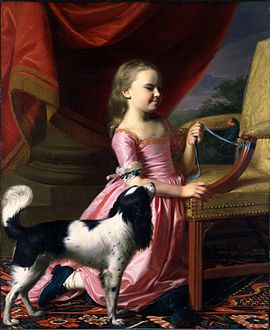
3 – 1767
| 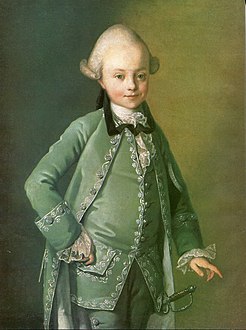
4 - 1770
| 
5 – 1762
|
|---|
2.Prince and Princess von Mecklenberg wear the miniature versions of adult costume that were standard for upper-class children, 1764.
3.An American girl of 1767 wears a pink satin back-fastening gown over a smock and black shoes with low heels.
4.Young Russian boy in court dress, with powdered hair and miniature sword, c. 1770.
5.Young Irish girls wear back-fastening bodices and sheer, embroidered aprons, 1762.
Working class clothing
Working-class people in 18th century England and the United States often wore the same garments as fashionable people—shirts, waistcoats, coats and breeches for men, and shifts, petticoats, and dresses or jackets for women—but they owned fewer clothes and what they did own was made of cheaper and sturdier fabrics. Working class men also wore short jackets, and some (especially sailors) wore trousers rather than breeches. Smock-frocks were a regional style for men, especially shepherds. Country women wore short hooded cloaks, most often red. Both sexes wore handkerchiefs or neckerchiefs.
Men's felt hats were worn with the brims flat rather than cocked or turned up. Men and women wore shoes with shoe buckles (when they could afford them). Men who worked with horses wore boots.

1-1764
| 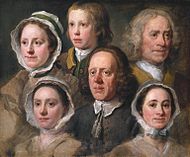
2-1750
| 
3-1764
|
|---|
2.Portraits of William Hogarth's servants (England, 1750s)
3.A working-class woman wears a short dress or bedgown, a patched and mended petticoat, and neckerchief (England, c. 1764)
Source from Wikipedia
没有评论:
发表评论